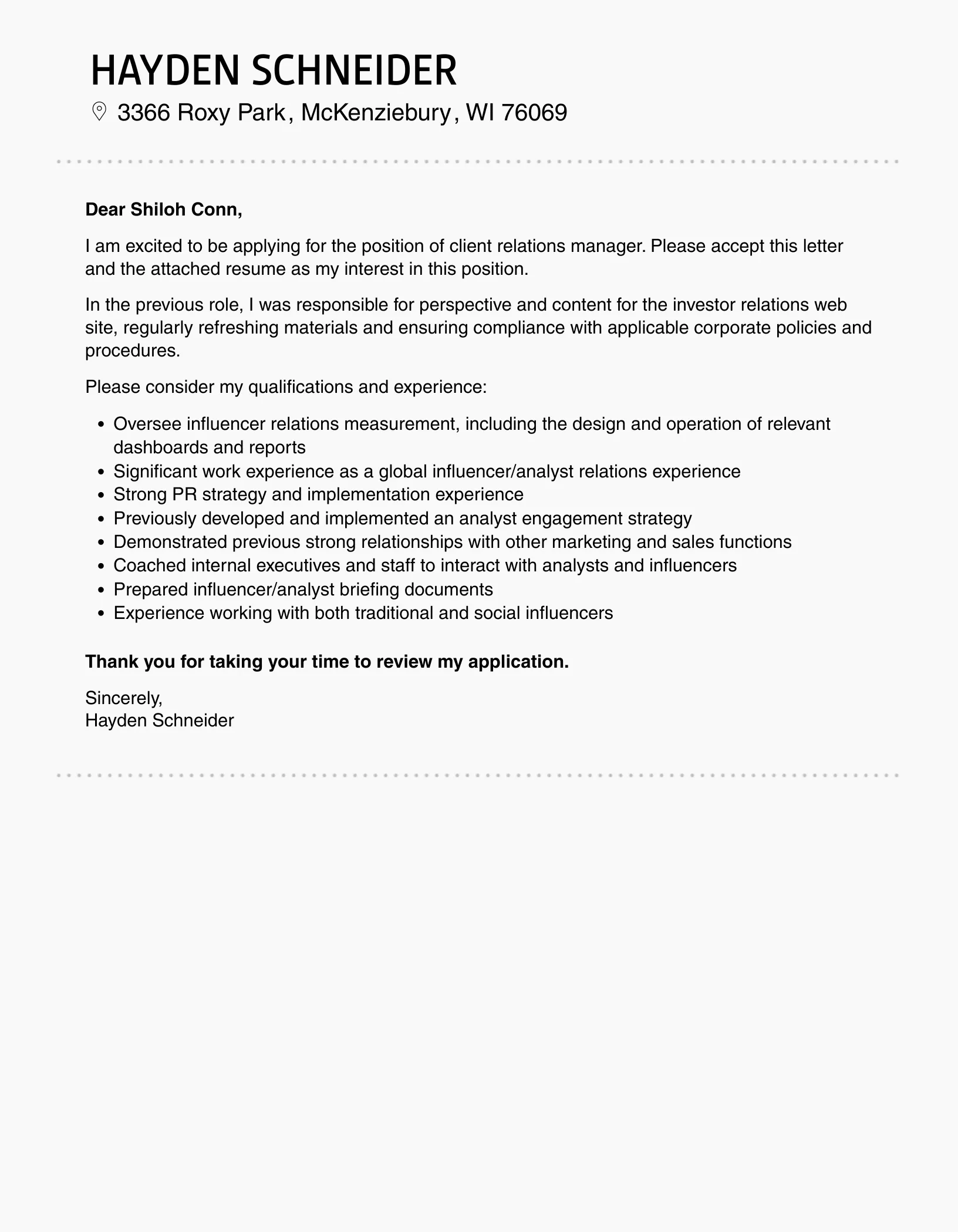Crafting a Compelling Client Relations Manager Cover Letter
A well-crafted cover letter is your first opportunity to impress a potential employer and secure an interview as a Client Relations Manager. It’s more than just a formality; it’s a crucial tool to showcase your skills, experience, and personality, setting you apart from other applicants. This guide will provide you with the essential steps to create a winning cover letter that captures attention and highlights your qualifications effectively. The key is to present a narrative that demonstrates your understanding of the role and how your unique skills and experience align with the company’s needs. Remember that the best cover letters are not generic; they’re tailored to the specific job and company, demonstrating genuine interest and a clear understanding of the responsibilities.
Understanding the Purpose of a Cover Letter
The primary purpose of a cover letter is to introduce yourself and persuade the hiring manager to read your resume. It offers a space to explain why you’re a perfect fit for the Client Relations Manager role and why the company should consider you. Unlike your resume, which lists facts, your cover letter allows you to tell a story. You can express your passion for client relations, illustrate how your skills align with the job requirements, and provide context to your experiences. Furthermore, it shows your communication skills, which is crucial for a Client Relations Manager. It demonstrates your ability to write professionally, organize your thoughts, and convey your enthusiasm, all of which are key to building strong client relationships. A well-written cover letter can make the difference between getting an interview or being overlooked.
Key Components of a Strong Cover Letter
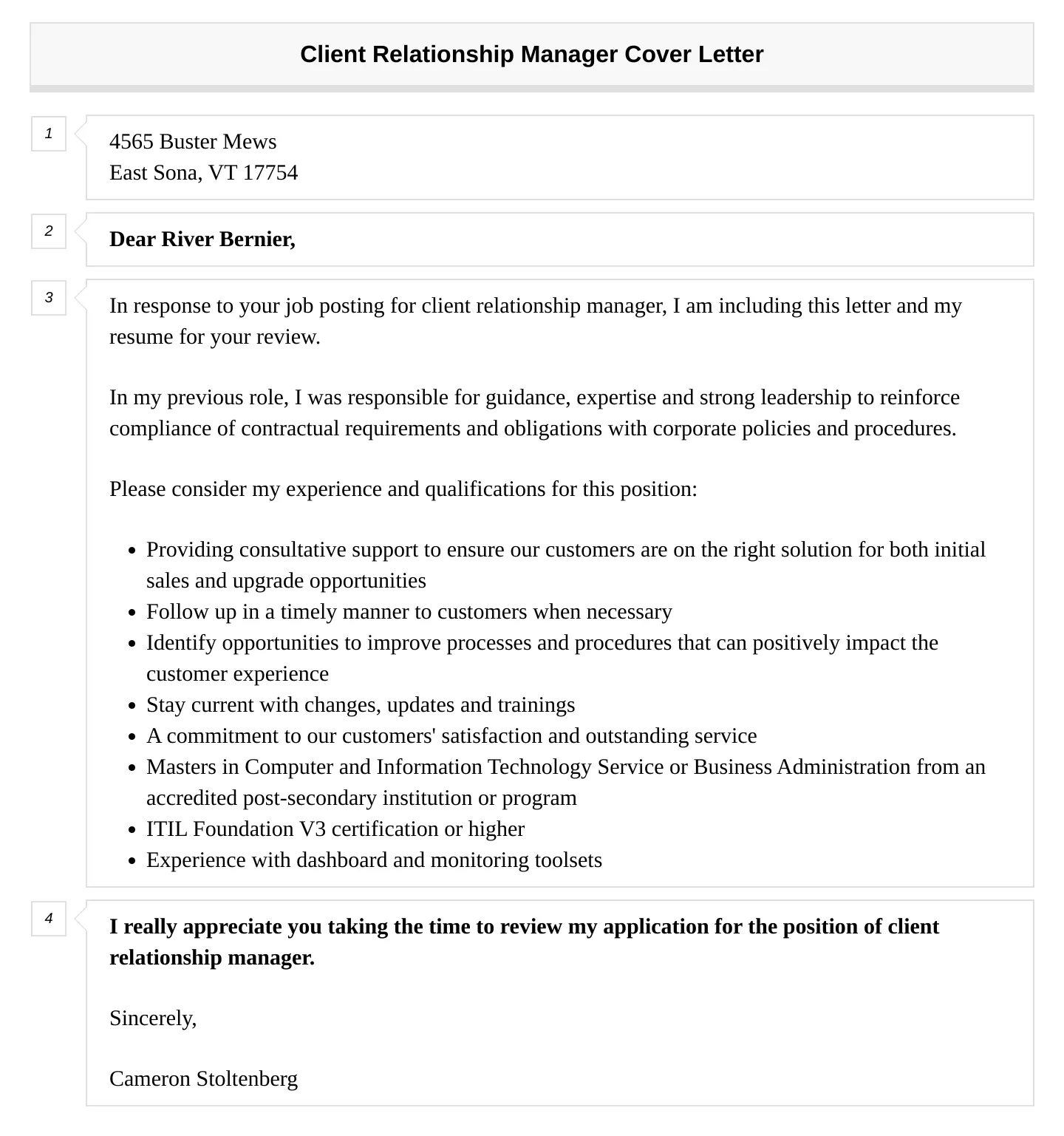
A strong cover letter follows a standard structure while allowing for personalization. This structure includes a clear header with your contact information, a compelling opening paragraph, a body that highlights your relevant skills and experience, and a concise closing with a call to action. The length should generally be no more than one page, making it easy for the reader to quickly grasp the main points. Each part of the letter should contribute to the overall narrative, showcasing how you can meet the company’s needs and the specific requirements of the role. The tone should be professional, confident, and enthusiastic, demonstrating a genuine interest in both the role and the company. Consider the impact of the language you use; action verbs and specific examples are more persuasive than general statements.
Header and Contact Information
The header is the first thing a hiring manager sees, so it’s important to make a good impression. Include your full name, address, phone number, and professional email address at the top of your cover letter. It is important to ensure that this information is accurate and up-to-date. Consider including a link to your LinkedIn profile as it can provide additional information and context about your professional background. Ensure your email address is professional; avoid using nicknames or unprofessional phrasing. Also, be sure to include the date and the hiring manager’s name and title, if you know it. Addressing the letter directly to the hiring manager is a great way to personalize your application and make a positive first impression, showing that you’ve taken the time to research the company and the specific role.
Formatting Your Cover Letter
Formatting is crucial for readability. Use a professional font like Times New Roman, Arial, or Calibri, and set the font size to 11 or 12 points. Maintain consistent margins (1 inch on all sides) and single-space the text within paragraphs, using a double space between paragraphs. Use clear headings and bullet points where appropriate to break up text and make the information easy to scan. The goal is to make your cover letter easy to read and visually appealing. Avoid excessive use of bolding, italics, or underlining, as this can distract from the content. Keep it clean, professional, and well-organized to show you pay attention to detail and respect the reader’s time. Remember that your cover letter is a reflection of your professionalism and your attention to detail.
The Opening Paragraph: Grabbing Attention
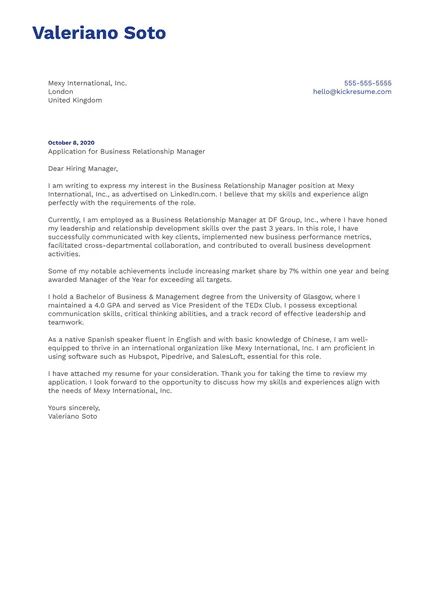
The opening paragraph is your first chance to grab the hiring manager’s attention. It should be concise, engaging, and clearly state the position you’re applying for and where you found the job posting. Instead of a generic greeting, try starting with a strong statement or a brief anecdote that demonstrates your understanding of the company or the role. You might express your excitement about the opportunity and how your skills align with the company’s values or goals. The introduction should briefly highlight a key accomplishment or skill that makes you stand out. Show enthusiasm and a clear understanding of the company’s mission. Consider using a mutual connection’s name if you know someone at the company. Make the hiring manager want to read further by making them interested.
Highlighting Your Skills and Experience
This is where you showcase your relevant skills and experience. Review the job description carefully and identify the key requirements. Then, in your cover letter, provide specific examples that demonstrate how you meet these requirements. Structure this section to align with the job’s needs. For instance, if the job requires strong communication skills, provide an example of how you successfully communicated with clients. This section must include examples of your achievements, quantifying them whenever possible. Focus on how you have helped previous employers or clients, emphasizing results and contributions to the success of the business. The key is to provide evidence to support your claims and show the value you can bring to the company.
Showcasing Relevant Experience
Detail your relevant work history in reverse chronological order, starting with your most recent position. For each role, describe your responsibilities and, more importantly, your accomplishments. Use the STAR method (Situation, Task, Action, Result) to structure your examples. Start by setting the context (Situation), outline what you needed to do (Task), explain your actions (Action), and then highlight the positive outcomes (Result). This approach helps the reader easily understand your contributions. Focus on experiences that directly relate to the Client Relations Manager role, such as handling client inquiries, resolving issues, building relationships, and contributing to client satisfaction. Make sure the experiences demonstrate a deep understanding of client needs and the ability to exceed expectations.
Quantifying Your Achievements
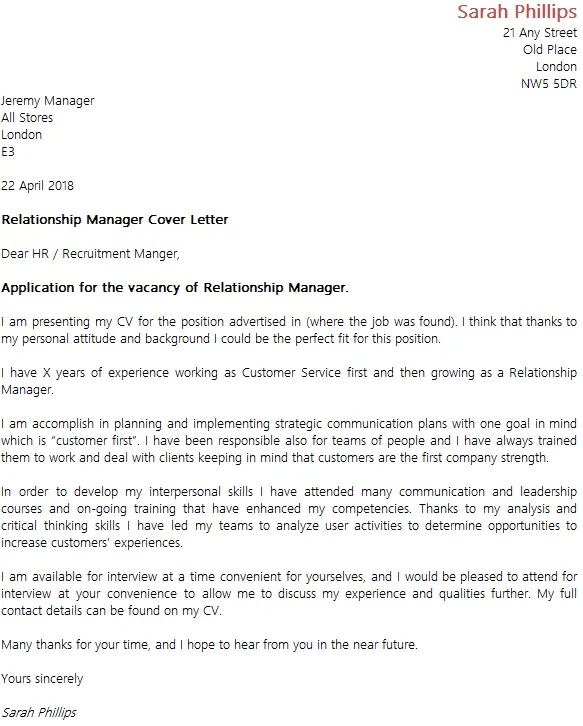
Whenever possible, quantify your achievements to make a more compelling case. Use numbers, percentages, and specific metrics to demonstrate your impact. For example, instead of saying ‘Improved client satisfaction,’ say ‘Increased client satisfaction by 15% through proactive communication and issue resolution.’ Use figures to show how you’ve increased revenue, reduced costs, or improved efficiency. This provides concrete evidence of your success and the value you bring. For instance, state the number of clients you managed, the size of the accounts, or any awards or recognition you received. When possible, provide tangible proof of your ability to deliver results, and use numbers and statistics to illustrate your success in previous roles. This makes your accomplishments more credible and convincing.
Demonstrating Client Relationship Skills
Client Relations Managers must have strong client relationship skills. In your cover letter, highlight your ability to build and maintain positive client relationships. Provide examples of how you have successfully managed client accounts, handled difficult situations, and fostered long-term relationships. Mention your communication skills, empathy, and ability to understand client needs. Consider using phrases like ‘building rapport,’ ‘managing expectations,’ or ‘providing exceptional customer service’ to showcase your people skills. Demonstrate your ability to communicate effectively, both verbally and in writing, to build trust and maintain client satisfaction. Show you are capable of managing client expectations and go above and beyond to meet client needs, driving loyalty and retention.
Emphasizing Communication and Interpersonal Skills
Communication and interpersonal skills are essential for client relations. In your cover letter, emphasize your ability to communicate clearly, concisely, and professionally. Highlight your skills in active listening, empathy, and building trust. Mention your experience resolving conflicts, handling complaints, and providing excellent customer service. Use action verbs like ‘communicated,’ ‘collaborated,’ ’negotiated,’ and ‘resolved’ to describe your past responsibilities. Showcasing these skills demonstrates your ability to interact effectively with clients and colleagues. Describe how you’ve built strong relationships, managed expectations, and resolved issues. These abilities are paramount for success in client relations and must be effectively showcased in your cover letter.
Showcasing Problem-Solving Abilities
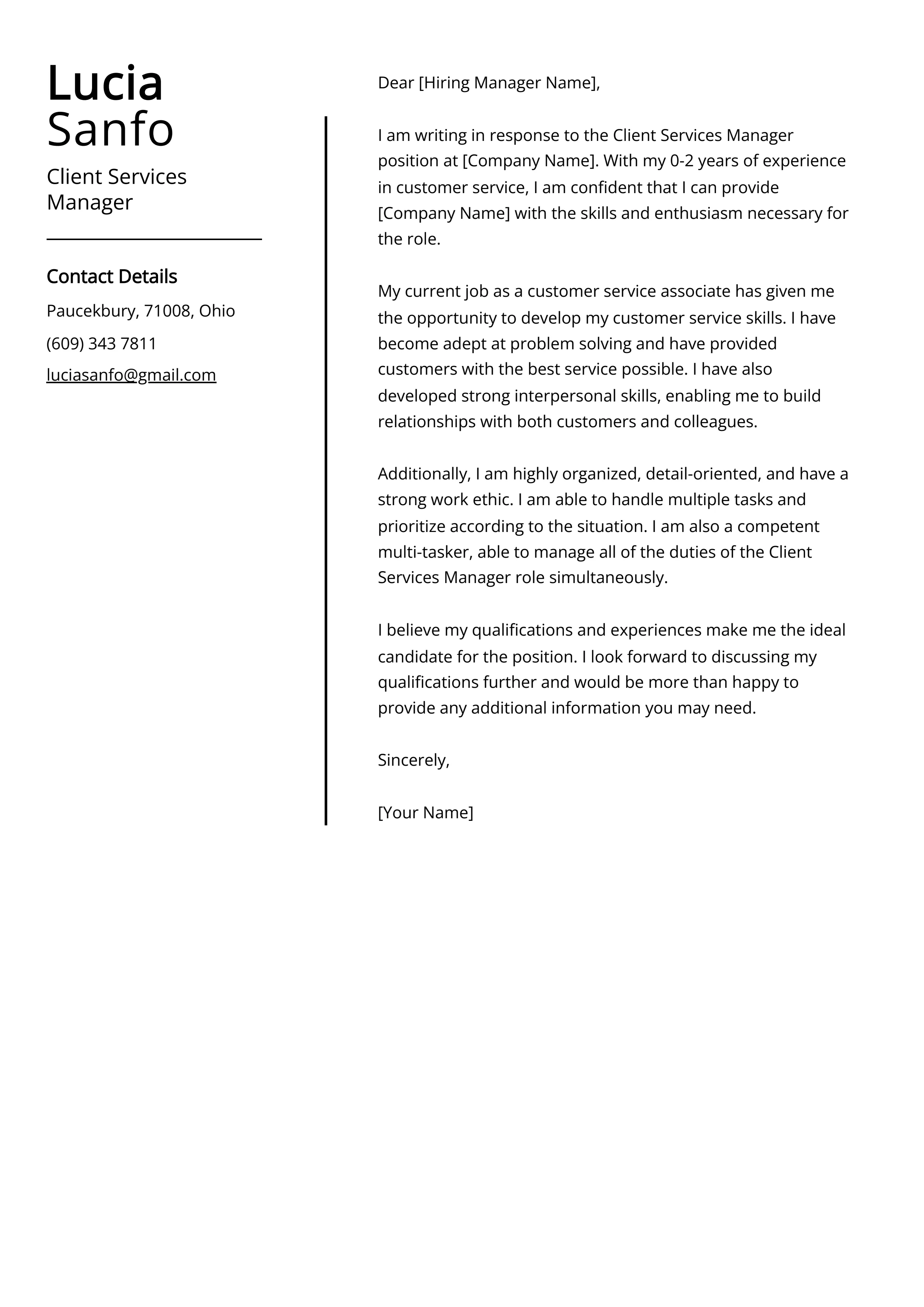
A Client Relations Manager frequently encounters problems and challenges. Demonstrate your problem-solving abilities by providing examples of how you’ve identified, analyzed, and resolved client issues. Describe the steps you took to address problems, the solutions you implemented, and the results achieved. Focus on your analytical skills, your ability to think critically, and your capacity to develop creative solutions. Use phrases like ‘analyzed,’ ‘identified,’ ‘resolved,’ and ‘implemented’ to showcase your abilities. Present specific examples of challenging situations you have successfully navigated, emphasizing how your approach led to positive outcomes. Showing your ability to solve problems is essential for building credibility and proving you are a strong candidate.
Tailoring Your Cover Letter
Always customize your cover letter for each job application. Generic cover letters are easy to spot and often overlooked. Review the job description carefully and identify the key requirements, skills, and qualifications the employer is seeking. Tailor your letter to address these requirements directly. Use keywords from the job description and incorporate them naturally throughout your letter. Show how your skills and experience align with the specific needs of the role and the company. Demonstrate you have taken the time to understand the company’s values, mission, and culture. Personalize your letter by mentioning something specific about the company or the role that interests you.
Researching the Company
Researching the company is essential. Before you write your cover letter, spend time learning about the company’s mission, values, and culture. Visit their website, read their ‘About Us’ page, and explore their social media profiles. Understand their products, services, and target market. If possible, research recent company news, initiatives, and any specific challenges they may be facing. This knowledge will help you tailor your cover letter to show a genuine interest in the company and how your skills can contribute to their success. Show your knowledge of the company’s achievements and strategic goals and demonstrate your understanding of the company’s vision. This research demonstrates your genuine interest in working for them.
Customizing Your Letter for Each Application
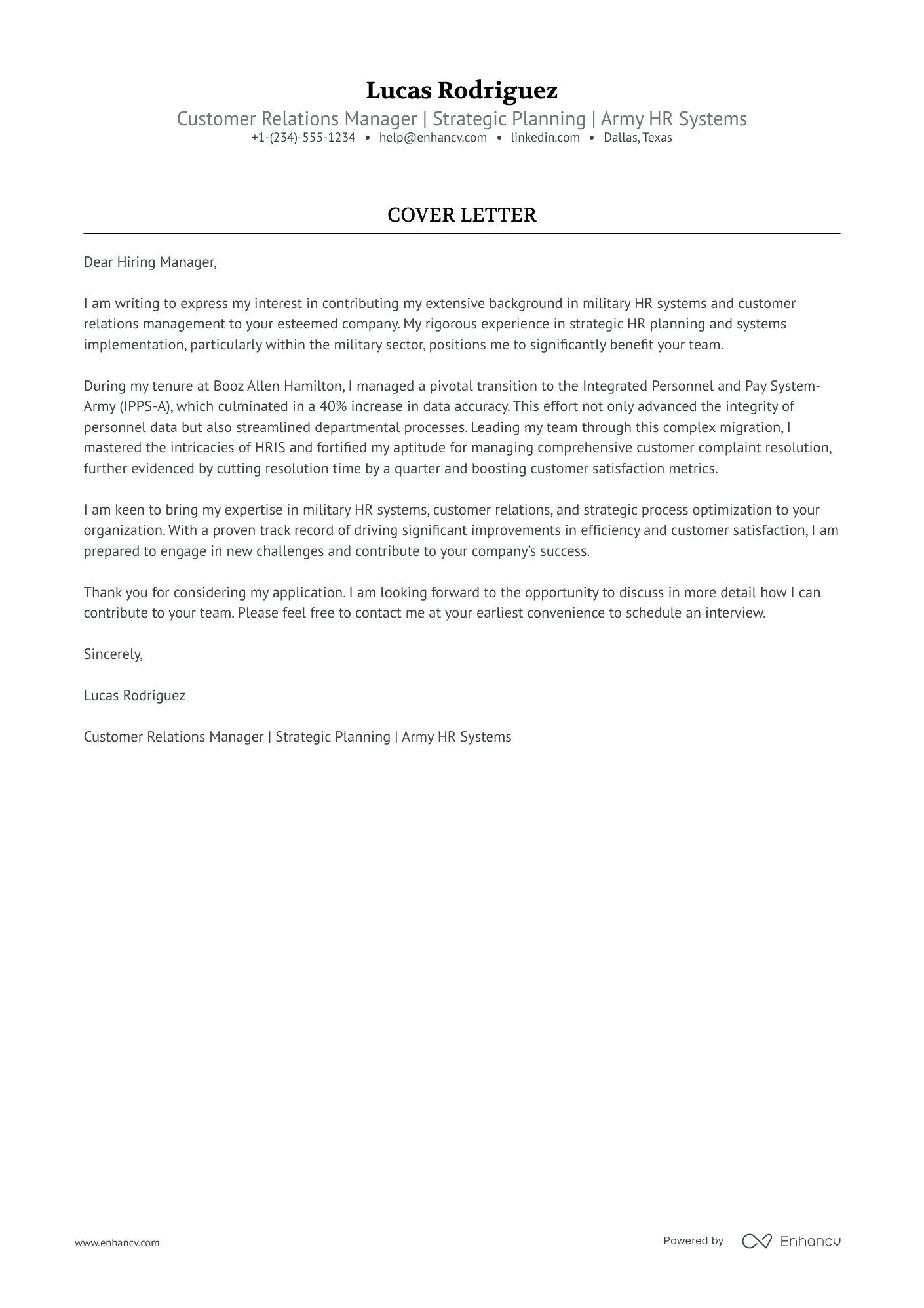
Personalize your cover letter for each job application by focusing on the specific requirements and desired qualifications mentioned in the job description. Avoid sending a generic cover letter that could apply to any position. Instead, tailor your letter to showcase how your unique skills, experience, and qualifications make you the perfect fit for the role. Use keywords from the job description throughout your letter. Refer to the specific tasks and responsibilities outlined and address them directly. Show the employer that you understand their needs and are ready to contribute immediately. Highlight the aspects of your background that are most relevant to the specific role. This personalization shows that you are genuinely interested in the opportunity and that you have taken the time to align your application with the company’s needs.
The Closing Paragraph: Call to Action
Your closing paragraph should reiterate your interest in the role and summarize your key qualifications. Express your enthusiasm and confidence in your ability to contribute to the company. Include a clear call to action. State that you are eager to learn more and discuss your qualifications in an interview. Thank the hiring manager for their time and consideration. Provide your contact information again, to ensure that the hiring manager can easily reach you. A strong closing paragraph leaves a positive impression and encourages the hiring manager to take the next step. Make the closing concise, professional, and focused on the future possibility of the interview.
Proofreading and Editing Your Cover Letter
Proofreading and editing are crucial steps. Carefully review your cover letter for any errors in grammar, spelling, and punctuation. Ensure your writing is clear, concise, and professional. Eliminate any typos or grammatical mistakes. Read your letter aloud to catch any awkward phrasing or sentences. Ask a friend, family member, or career advisor to review your cover letter for feedback. A second pair of eyes can often spot errors you may have missed. Ensure that the letter flows logically and presents your qualifications in a compelling manner. Pay attention to the tone and make sure it matches the professional context. A polished and error-free cover letter demonstrates attention to detail and shows that you care about making a positive impression.
Common Mistakes to Avoid

Several common mistakes can undermine the effectiveness of your cover letter. Avoid generic language and clichés. Refrain from simply restating your resume; instead, provide context and tell a story. Do not include irrelevant information or details that are not directly related to the job. Keep the tone professional and avoid being overly casual or informal. Avoid spelling and grammar errors. Don’t use the wrong company or contact name. Avoid mentioning salary expectations unless specifically requested. Finally, do not exceed one page in length. By avoiding these common pitfalls, you can significantly improve the quality of your cover letter and increase your chances of securing an interview. Proofread carefully and make sure your letter reflects the high standards you want to be associated with.
Ensuring Professionalism and Polished Presentation
Ensure that your cover letter looks professional and is well-presented. Use a professional font, such as Times New Roman, Arial, or Calibri, in an easy-to-read size (11 or 12 points). Maintain consistent margins and spacing. Make sure the layout is clean and organized. Proofread the letter carefully for any errors. Use high-quality paper if you are submitting a printed copy. Pay attention to the overall tone and ensure that your letter reflects your professional demeanor. A well-formatted and polished cover letter communicates respect to the hiring manager. Before submitting your cover letter, double-check every detail to ensure it presents you in the best possible light. A polished cover letter shows that you pay attention to detail.
